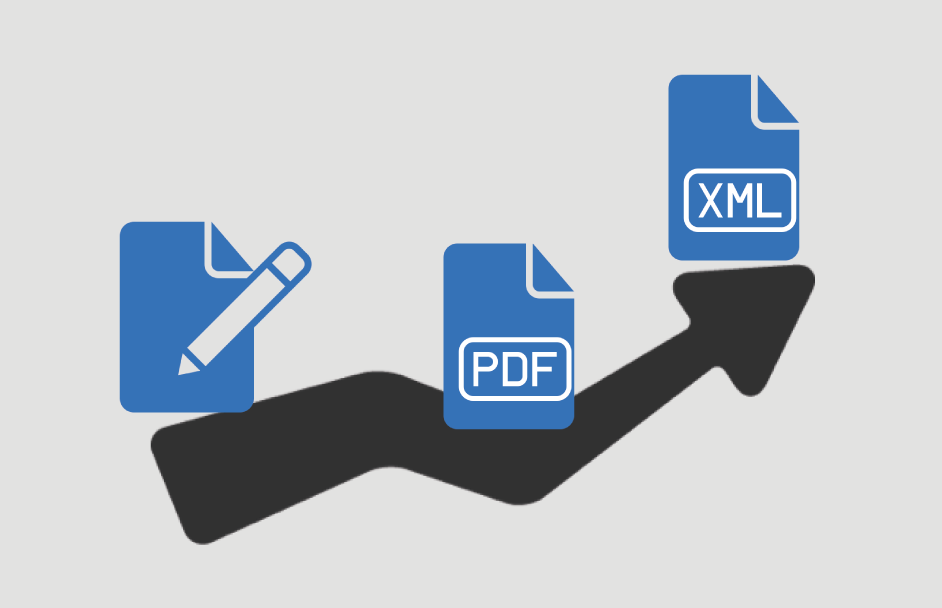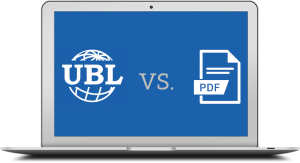
In this blog article, I compare 2 commonly used invoice formats UBL and PDF. In 10 minutes, you will have more knowledge about the similarities, differences, market shares, government vision and how the Peppol network works. I conclude this blog with a tip for TriFact365 users about Peppol.
UBL and PDF agreements
Hundreds (!) of digital invoice formats are used worldwide. In the Netherlands, PDF is by far the leading format and UBL is booming. Without judging what is right or wrong, this blog article explains what these differences mean, what strengths or weaknesses they may have and what this may mean for digital invoice processing.
Differences between UBL and PDF
PDF or UBL are regarded as competing counterparts, while it could be questioned whether they are comparable. PDF provides a visual preview of the document, while UBL encodes it. This makes PDF more insightful, but UBL more protected. A UBL code can only be read by special software and is specifically designed for communicating invoices. Therefore a UBL invoice is often accompanied by a PDF invoice. UBL communicates from machine to machine which is fast, efficient and also less prone to error. The disadvantage of PDF is that 100% recognition by accounting or scanning and recognition software is far from always possible. UBL invoices guarantee 100% recognition of invoice elements, such as amount, invoice date, invoice number, Chamber of Commerce number and bank account number of supplier and creditor.
Market shares
More and more accounting and related software are implementing capabilities to create, send and process UBL invoices. This is partly due to the fact that UBL is now also increasingly used in the Netherlands and leads to demonstrable savings. However, PDF invoices have not yet disappeared. The average consumer and SME entrepreneur does not benefit from a UBL invoice because they do not have the right software. SME entrepreneurs want insightful invoices and therefore prefer PDF. As a result, most sole traders and SMEs work more with PDF invoices than UBL invoices. The two systems thus respond differently to the need for clear financial communication.
Suppliers to government must e-invoice
The government is digitising all procurement channels. From 2017, e-invoicing via Peppol is mandatory to the government. To this end, the central government has set up an e-invoice portal. In 2020, the Dutch Peppol authority was adopted by the Ministry of the Interior and Kingdom Relations (BZK). Which shows that the Dutch government really wants to oversee the national infrastructure for e-invoicing.

Impact for SMEs and accountants?
Only a very small proportion of SME entrepreneurs and accountants deal with supplies to the government. So the impact of the obligation is still small. However, accountants now have to deal with hybrid situations in which UBL invoices will also become increasingly common in SMEs and will gain serious invoice volume alongside PDF.
All-in-one solution for UBL and PDF?!
Scan-and-recognition solutions cleverly capitalise on current hybrid market situation. Until now, the focus has mainly been on processing PDF invoices, but the demand for UBL processing is increasing. TriFact365’s Scan and Recognise has adapted to this demand, processing all common UBL invoices in addition to PDF invoices for years. This allows the entrepreneur to invoice with the system that suits him or her best and the accountant does not experience any problems processing digital invoices.
How next? Evolution to Peppol
What if you combine the benefits of UBL with the advantages of PDF? That’s what they thought at OpenPeppol, the non-profit organisation whose goal as of 2008 is the standardisation of cross-border e-invoicing. Within the Peppol network, you can send and receive digital invoices in a combined UBL and PDF format. Peppol is now also embraced by several accounting packages in the Netherlands and adoption is growing steadily.
Tip on Peppol for TriFact365 users
If you use TriFact365 Scan and Recognise, you are already able to process UBL invoices. You can use TriFact365 to automatically recognise all incoming UBL invoices and forward them as journal entries to your accounting package. Already thinking about concrete participation in the Peppol network and considering applying for your own Peppol ID? Let us know that you would like a Peppol ID, and we will inform you as soon as the time comes!
What kind of standard is UBL?
UBL has the following versions: UBL 1.0 (2004), UBL 2.0 (2006) and its successor 2.1 (2013). In practice, UBL 2.0 and 2.1 are used. The differences between UBL 2.0 and 2.1 are minimal as far as the standard invoice is concerned. Version 2.1 has been officially adopted as an international ISO/IEC standard. The Dutch government uses UBL as a standard for digital invoicing, however, they use their own variant: UBL-OHNL. So there are more countries and companies with different requirements which eventually leads to different variants. This can be disadvantageous because it is not clear what exactly is on the invoice and what can then be adopted by the software.


